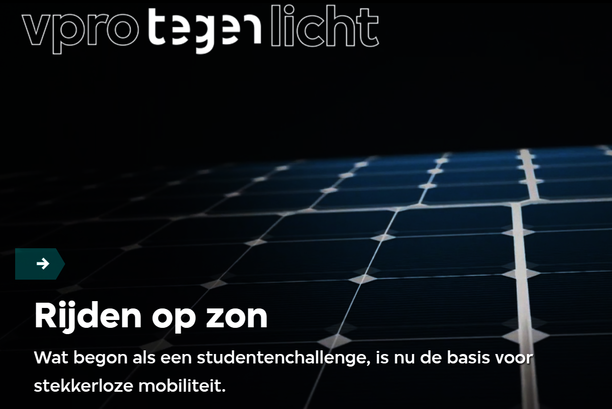How Solar Team Eindhoven’s message of sustainability could be heard as far as southern Spain
TU Eindhoven students believe sustainable transition can be accelerated and show what is technologically possible.
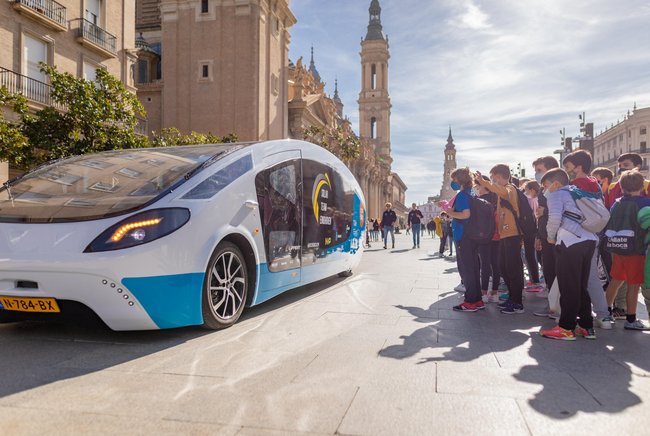
Solar Team Eindhoven (STE) built a self-sufficient house on wheels in one and a half years and travelled to the Spanish south coast in four weeks. The vehicle attracted enormous interest. We drove with the team from Zaragoza to Madrid. In twelve-hour shifts, a sense of belonging and mission of sustainability. "I'm expecting a call from Elon Musk soon".
It's a sunny Wednesday morning when a striking form escorted by a police car drives into one of Europe's largest squares. On the Plaza del Pilar in Zaragoza, Spain, passers-by slow down when the teardrop-shaped vehicle with solar panels comes into view. Bystanders point, tap each other or reach into their pockets for their mobile phones to capture the scene. Soon a circle of interested people forms around the four-wheeler. Young children look on in amazement.
This no longer surprises the students of Solar Team Eindhoven (STE). Everywhere the Stella Vita goes, she’s the main attraction. Not in the least because of the futuristic appearance that makes it seem as if the vehicle has come straight from the future. The British Daily Mail even compared Stella Vita to the flying car Chitty Chitty Bang Bang from the classic 1968 film of the same name.
Traffic jam
The interest sometimes goes so far that motorists on French and Spanish motorways drive next to the Stella Vita and film the vehicle extensively for minutes on end. Because the four-wheeler clocks an average speed of 85 kilometers per hour (its ideal operating efficiency), the result is a minor traffic jam. "We urge motorists to drive on, because we don't want to be a danger on the road," explains team manager Kjell Revenberg. Then, laughing, "Of course I understand the attention, but we are quite a spectacle, aren't we?"
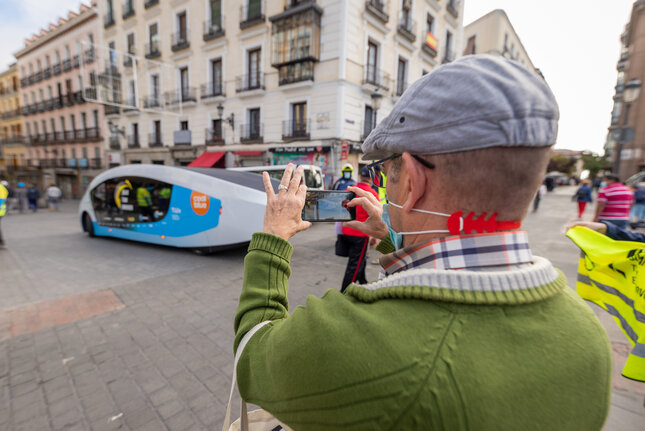
The team can already dream up the most frequently asked questions. This morning in Zaragoza, passers-by mainly want to know how expensive the motorhome is, who made it and where they can buy it. The answer - Stella Vita is not for sale anywhere and was conceived and made by students - causes amazement and admiration. Meanwhile, police officers take photos with the four-wheeler. Thumbs up.
Time for something else
The team is pleased with the great interest from media and public. Exactly what Solar Team Eindhoven was hoping for when they sat down together one and a half years ago to come up with a new concept. The student team had just become world champions for the fourth time with their solar-powered family car during the World Solar Challenge in Australia and therefore wanted to take a different route. Revenberg: "It was time for something different."
Ideas for a motorhome were quickly tossed around the table, but STE wanted more. After one and a half months the students decided to build a self-sustaining house on wheels that provides enough electricity to drive, cook, shower and watch television thanks to foldable solar panels. Thus SHOW (Self-sustaining House on Wheels) was born as a concept. The vehicle was given the name Stella Vita. The media quickly followed with their description as the 'greenest motorhome in the world'.

STELLA VITA REACHES FINAL DESTINATION SOUTH SPAIN
The world's first fully self-sufficient 'house on wheels' - designed and developed by students from Eindhoven University of Technology - will arrive in Tarifa, the southernmost tip of Spain, on Friday. This means that Solar Team Eindhoven has reached the final destination of its tour from the Netherlands to Spain on energy from the sun. The student team organised the trip to show the future of sustainable mobility with their self-built greenest campervan in the world.
Colorful procession
Back to Zaragoza, where the group leaves the Plaza del Pilar after a few hours to head for Madrid via the Autovía A-2. A trip of more than 300 kilometers through a landscape of rolling hills. The route was meticulously planned beforehand so that nothing was left to chance. Each of the 22 students was assigned a task and got into one of the vehicles that together travelled in a colorful procession over the tarmac towards the capital.
Freddy is in front and hurries towards the next accommodation to check that everything is okay there and to see whether all the through roads are actually accessible. Then you have the scout. This car drives in front of Stella Vita to detect any minor roadblocks or calamities (like a broken-down car) and pass this on to the team.
Behind the scout is Strat, the van that determines the strategy and uses data (such as temperature and generated energy) to monitor Stella Vita for defects. Stella Vita follows, with Primary right behind it, equipped with a first aid team that will intervene if something really goes wrong. A trailer with the materials and the luggage completes the column. Around this procession circles the media vehicle that produces the nice pictures and videos, as you can see in this report.
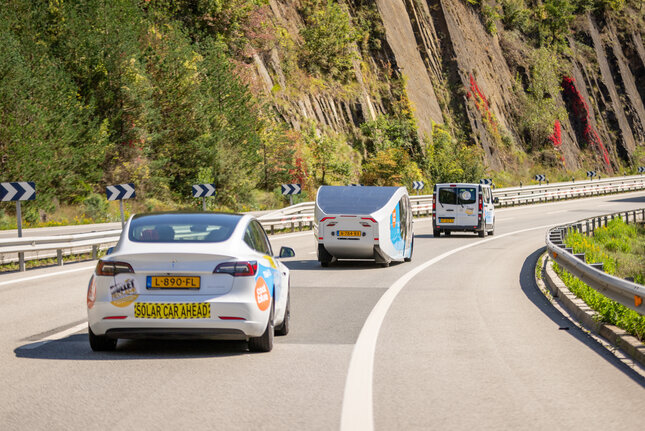
Friends Club
A friends club is how Revenberg describes the team. And just as well, because they have done a lot of work. When the RDW (Dutch vehicle authority) inspection approached, just before the start of the trip to Spain, the team worked overtime. (Night) shifts of 12 hours were the rule rather than the exception. The team is very fanatical, as the team manager confirms. "At a certain point we really had to send each other home and make sure that people got some rest. We regularly held a mentality meeting to see how everyone was doing. Not to talk about the work, but about the person. We wanted to prevent team members from getting ahead of themselves."
Passing the RDW inspection, which allowed the vehicle to officially drive on the road, felt like a victory. But the long shifts didn’t end there, because just before the start of the trip to Spain the driveline malfunctioned. The technical problem meant that the required test kilometers had to be cancelled.
Revenberg: "So we had to work overtime again, because ultimately safety comes first. Without those test kilometers, we didn't want to let Stella Vita drive on the public roads. We solved the problem, transported Stella Vita in a trailer to France, drove the necessary test kilometers on a test site and then got our vehicle onto the public road. That was a wonderful moment!"
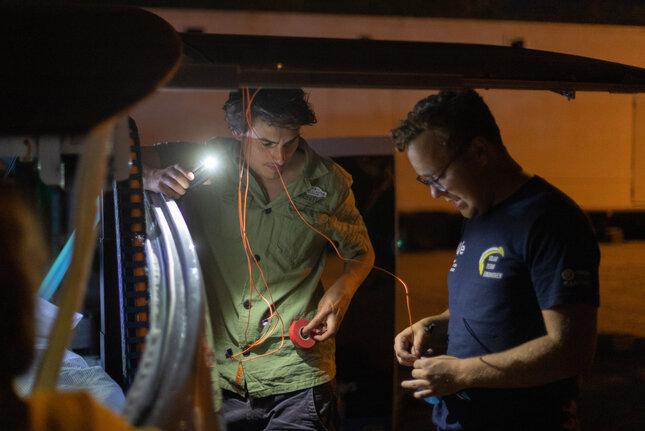
Broken night
In the evening, the group arrives in Getafe, a suburb in the south of Madrid. The team is tired but works through the night on some small issues that came to light during the long drive. Although these small issues don't hinder the rest of the trip, it does mean a broken night’s rest for the team's engineers.
The lack of sleep does not affect the team's mood. The next morning Stella Vita is up on show early in the garden of the Dutch embassy in Madrid, where STE is invited by ambassador Jan Versteeg to talk about the sustainability mission that is linked to the project. Versteeg welcomes everyone and speaks of the future that is literally driving around the corner. He then addresses the team: "You have created something that industry is not yet able to deliver. You have taken sustainability to the next level."
Tijn ter Horst and Lotte van Dasler, two members of STE, then tell the audience how they want to contribute to accelerating the energy transition. They talk about the three pillars on which Stella Vita is built: efficiency, renewable energy and self-sufficiency.
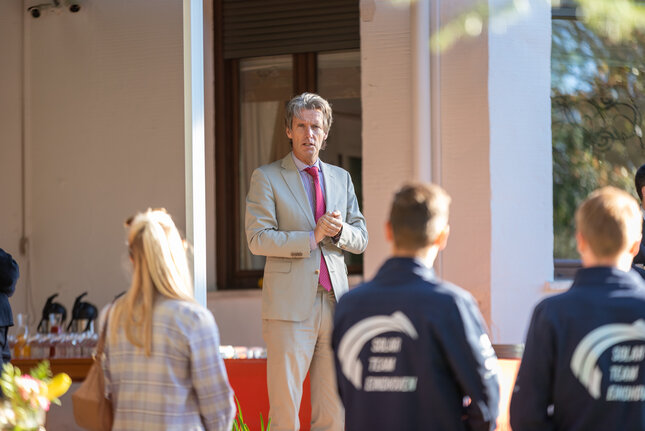
In order to cover as many kilometers as possible, the vehicle had to be extremely streamlined. Therefore, the teardrop shape was chosen with a relatively low roof compared to other motorhomes. This keeps the air resistance low. Once parked, a retractable roof allows people to stand in the vehicle. Via retractable solar panels, Stella Vita generates enough solar energy for driving and living. A charging station is therefore not necessary. In this way, the team combines efficiency with self-sufficiency, using a renewable energy source.
Madrid sustainability researcher Pablo Frías is also present and visibly impressed: "You are changing the way we think." This is also exactly what the team aims to do, explains Revenberg. "We are not doing this from a commercial point of view, but believe that the sustainability transition can and must be faster. Actually, in terms of innovation, we are 5 to 10 years ahead of the market."
He calls on large companies to go off the beaten track and explore which innovations can make their carbon footprint smaller. "I'm not saying they should do the same as us, but if 22 students want to be able to design and build a completely self-sufficient house in a year and a half, then surely big companies should also be able to make big steps in a short time? That's what we want to draw attention to."
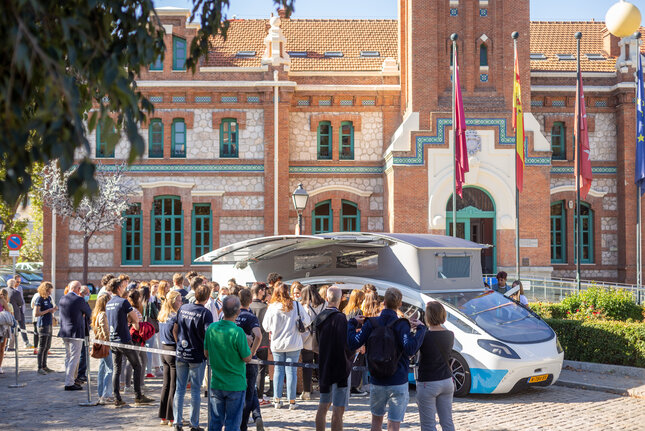
Roller Coaster
The message is clear, and the students tirelessly convey it every day on this trip. At universities, embassies, the European Parliament or other events. It is admirable how apparently easy it is for STE to maintain this enthusiasm during the long days that mainly consist of travelling, tinkering and spreading the message.
"That is what I am most proud of, the passion and solidarity within the team. The trip is one big roller coaster, but we’ve had a lot of very nice moments on the whole. We visit beautiful cities and everywhere people want to hear our story. The media, local people, large companies; everyone thinks what we are doing is cool. That's great fun," Revenberg explains on this afternoon in the heart of Madrid, with the trip’s final destination, Tarifa, still a week away.
After the trip, it will be time for the team members to kick back and return to their studies at TU Eindhoven in subject areas such as mechanical engineering, electrical engineering, computer science or industrial design. "It will certainly take some getting used to," agrees the team manager, "but it has been a wonderful time in which we all learned a lot. What will happen to Stella Vita? Well, the big dream is that there will be a company that actually takes our ideas to the next level. Has Elon Musk contacted us yet? Well, I’m expecting him to call at any moment!"
Mediacontact
Latest news



